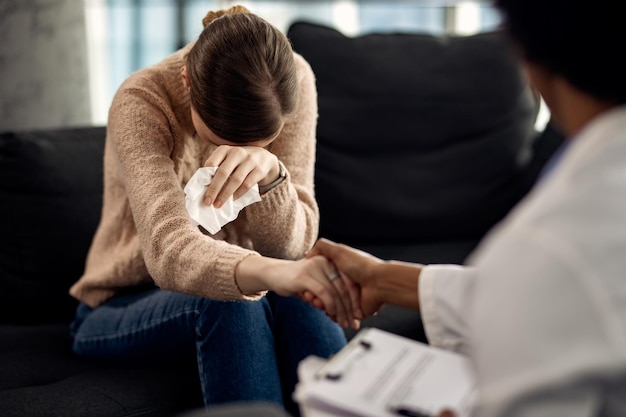The U.S. Preventive Services Task Force is now advising that youth 8 to 18 have regular screenings for anxiety, and with May marking Mental Health Awareness Month, Mayo Clinic is urging parents to be mindful of signs.

Marcie Billings
Youth mental health in general is a rising concern among families and health care providers, with organizations including the American Academy of Pediatrics, American Academy of Child and Adolescent Psychiatry and Children’s Hospital Association last fall declaring it a national emergency.
“Even before the pandemic we were seeing increased rates of mental health (issues). The pandemic just kind of exploded the mental health crisis,” says Dr. Marcie Billings, pediatrician at Mayo Clinic Rochester.
The National Emergency declaration, Billings adds, “was not surprising to us as frontline primary providers for children.”
Per the Wisconsin Department of Health Services September 2020 “Suicide in Wisconsin” report, the suicide rate among residents rose 40% between 2000 and 2017, and 271 adolescents ages 10-19 died from suicide between 2013 and 2017, making it the second leading cause of death among 10 to 19 year olds.
People are also reading…
The first year of the pandemic drove a further rise in suicide, with the CDC reporting that between March to October 2020, emergency department visits for mental health crisis increased by 24% for youth ages 5-11 years and 31% for youth 12-17. Emergency visits for suspected suicide attempts increased nearly 51% among girls age 12 to 17 years from early 2019 to early 2021.
According to the National Research Council and Institute of Medicine, around 32% of U.S. youth have experienced an anxiety disorder, and the Wisconsin Department of Health Services reports that in 2017 in La Crosse County, 41% of youth did not receive treatment for their mental health conditions.
In a recent Tribune column, Liz Evans of Great Rivers United Way cited a 2021 COMPASS report that showed the ratio of mental health providers to the population in La Crosse County is 1 to 320. NAMI (National Alliance on Mental Illness) puts the average delay between the onset of mental health symptoms and treatment at 11 years.
Evans further references the 2018-19 Youth Risk Behavior Survey of La Crosse County high school students, for which 48% of students stated they had significant problems with anxiety, while 29% felt they were at-risk for depression and 15% had seriously considered suicide. Further, 45% said they rarely or never get the emotional help they need.
Youth who identify as LGBTQIA or are members of underserved populations have a greater prevalence of mental health concerns, Billings says, and the CDC reports Black and Hispanic youth have higher levels of anxiety and other mental health conditions.
Individuals of all ages, Billings notes, can experience mental health challenges, and the pandemic has created “trauma across the board.”
“Kids are just so impressive in terms of their ability to be resilient. We have tested that, however, in the current state of the pandemic, and this is where the entire family unit really needs to be aware of what to do and how to do it,” Billings says.
Distinguishing between depression and anxiety and general teen mood shifts can be difficult, Billings says, noting it is “not uncommon” for her to diagnose either of those conditions when the parents didn’t recognize it. In addition, symptoms like stomach or head aches or insomnia could be mental health related rather than a physical issue, and some conditions could materialize in an abnormal fashion.
Whereas for many individuals eating disorders begin with intentional changes in diet, over the pandemic Billings has seen anorexia manifest from pandemic related alterations to routine. With schooling from home for a period, teens were not “getting environmental cues” like a scheduled lunch break, routine of grabbing food with friends on the weekends or the same hunger patterns.
“All of a sudden they are starting to lose weight and when the brain doesn’t get as many calories, (it doesn’t) work like (it) used to,” Billings says. “They become more irritable and it’s a cascade of events.
“I am looking with a very keen eye and strict lens these days to make sure I don’t miss that and (fail to) address that,” she says of drops in weight or going off track on the growth chart.
Mental health disorders can mimic some normal teenage responses, and brief periods of irritability, anger, and reclusiveness don’t always warrant concern. When a behavior persists for weeks at a time, however, that is a “big clue and a red flag this is more of an issue than typical teenage behavior.”
Adults should be cognizant of changes in their child’s eating habits, socialization, sleep, grades, interest and energy levels in order to “get these kids in (the clinic) in a timely fashion to get them the care that they need.”
“We really need to be proactive in letting them know we are there for them,” Billings says, because “to expect that your teen is going to come to you with these issues is a high expectation.”
Check in regularly, she advises, even if it takes many retorts of “I’m fine” before they open up. Instead of a reticence to share their struggles, youth could be staying quiet out of fear of burdening their guardians.
“Teens don’t want to add to the stress of their parent — that is an incredibly consistent theme I hear,” Billings says.
To screen for mental health disorders, providers may use tools like the Pediatric Symptom Checklist and ask patients about their home and school life in addition to talking about emotions and moods. Medication, counseling or other medical interventions may be necessary, though parents can help by implementing or enforcing certain practices.
Routine is important, but, especially during the pandemic, there needs to be room for flexibility, Billings says. Though there may have been a pause in sports or extracurriculars, most activities have resumed and, in general, youth are overscheduled with homework, jobs, athletics, clubs and internships.
“I sometimes ask my teenage patients, ‘Do you have any down time, do you ever just hang out?’ Downtime is important.”
Encouraging children to volunteer or help others can provide “a sense of purpose,” Billings says. Parents should make sure they also partake in activities that spark joy and make time for relaxation, meals and sufficient sleep.
“Our kids watch us, they look to us for what should we be doing,” Billings says. “Modeling good self care for ourself can really help our kids.”
Social media usage, Billings says, is a tricky topic, as apps can become consuming, trigger body image issues, increase bullying or lead to poor sense of self worth. However, during social distancing screens were the alternative to physical contact.
“It is really not surprising this has become such a challenge,” Billings says. “For this time period, in the state that we’re in, electronics are probably going to be utilized more for socialization experiences that these kids just haven’t gotten in the way we wish that they could.” Time limits or access restrictions may vary from person to person.
Youth and their parents can access local programs and resources for mental health through schools, hospitals, and organizations. The Great Rivers United Way (GRUW) recently provided $127,000 in funding for youth mental health programs from the Boys and Girls Clubs, YWCA, Boy Scouts, Girl Scouts, and Big Brothers Big Sisters. GRUW has also facilitated Youth Mental Health First Aid training and leads the Better Together community collaboration, which focuses on improving mental health and increasing conversations and awareness of the topic.
For a list of area mental health service providers and resources, visit http://mentalhealthlacrosse.org/resources/
IN PHOTOS: UW-La Crosse donates gift baskets to healthcare workers
Donations

UW-La Crosse staff and faculty deliver gift baskets Tuesday afternoon at Gundersen.
Donations

Donations from the UW-L campus community are delivered at Gundersen.
Donations

Nurses and a representative from the Gundersen Medical Foundation met the UW-L students and faculty.
Donations

Donations from the UW-L campus community are delivered at Gundersen.
Donations

The gifts — including snacks, games, gift cards, thank-you notes and more — were donated by the UW-L campus community.
Donations

Donations from the UW-L campus community are delivered at Gundersen.
Donations

Donations from the UW-L campus community are delivered at Gundersen.
Donations

The gifts — including snacks, games, gift cards, thank-you notes and more — were donated by the UW-L campus community.
Donations

Donations from the UW-L campus community.
Donations

Nurses and a representative from the Gundersen Medical Foundation met the UW-L students and faculty.
“Even before the pandemic we were seeing increased rates of mental health (issues). The pandemic just kind of exploded the mental health crisis.”
Dr. Marcie Billings, pediatrician at Mayo Clinic Rochester







